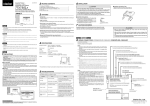Download ” e
Transcript
lIIIIIIlllllllIIIIIIIIIIIIIIIIIIIIIIIlllll|IIII||II|||I||II|I||Il|||||||ll| USOO5568120A United States Patent [19] Patent Number: [45] Date of Patent: 5,568,120 [11] LeMense et al. [54] ANTI-THEFT SYSTEM WITH REMOTE CONTROLLED VERIFICATION OF ARMING Oct. 22, 1996 OTHER PUBLICATIONS “Remote Plus” Alarm System Operating Instructions, 1991 R. Tengler, West Bloom?eld, both of Model Year. 1993 Mark VIH Service Manual, Section 01-14B Keyless Mich. Entry System, pp. 01-14B-1 through 01-14B-9. [75] Inventors: Thomas J. LeMense, Livonia; David 1994 Probe Service Manual, Section l3—11 Anti-Theft [73] Assignee: Ford Motor Company, Dearborn, Alarm System, pp. 13-11-1 through l3—l1—3. Mich. Primary Examiner—Je?°ery Hofsass Assistant Examiner—Julie B. Lieu Attorney, Agent, or Firm—Mark Mollon [21] Appl. No.: 350,296 Dec. 6, 1994 [22] Filed: [51] Int. Cl.6 ....................................... .. B60R 25/10 [52] US. Cl. ..................... .. 340/426; 340/425.5; 340/539; [58] [57] ABSTRACT A remote controlled anti-theft system for transportation 180/287; 307/102 vehicles allows the user to easily determine at will if a faulty Field of Search ............................... .. 340/426, 425.5, door position sensor or an open door will inhibit proper 340/430, 539, 825.69, 825.72; 361/172; operation of the anti'theft system by pressing the lock button 307/10.2; 180/287 on the remote transmitter in a predetermined sequence. A ?rst lock code from the remote transmitter initiates a locking and arming sequence of the anti-theft system. A second lock code received within a predetermined time of the ?rst lock [56] References Cited U.S. PATENT DOCUMENTS 4,383,242 4,884,055 code causes an audible veri?cation to be produced identi fying whether the anti-theft system is successfully arming or 5/1983 Sassover et a1. ...................... .. 340/426 11/1989 Memmola .... . . . . .. 4,887,064 12/1989 Drori et a1. 340/426 whether a door ajar or faulty door sensor is preventing the 340/426 anti-theft system from arming. 5,113,182 5/1992 Suman et a1. .. 5,307,048 4/1994 Sonders 340/82531 5,381,128 1/1995 Kaplan .................................. .. 340/426 340/426 4 Claims, 2 Drawing Sheets @20 oooas LOCKED WITH REMOTE FOB I INDICATE READY TO ARM 22 / 30 2ND LOCK COMMAND RECEIVED WITHIN 5 SEC? ARE ALL DOORS YES i/ CLOSED? 'CHIRP“ HORN TWICE (UNABLE TO ARM) ARE ALL DOORS CLOSED? “CHIRP' HORN ONCE (LOCKED 8r ARMING) HAS 30 MINUTES 7 COUNTDOWN FOR 30 SECONDS Z6 ELAPSED? / (EXIT DELAY) I FULLY ARM ANTI-THEFT SYSTEM 27 CANCEL PRE-ARM CONDITION @” e@ US. Patent 0a. 22, 1996 Sheet 1 of 2 . 5,568,120 Y7” ‘2X7 MM /7/-E] El //3 III /6’ 4 // , REMOTE ANTI-THEFT —> Ii}? MODULE H6]. DOOR MODULE —-> LOCK ACTUATOR US. Patent Oct. 22, 1996 Sheet 2 of_2 5,568,120 @w DOORs LOCKED l/Z/ WITH REMOTE FOB ¢ 22 INDICATE READY TO ARM / 30 2ND LOCK COMMAND RECEIVED WITHIN 5 SEC? ARE ALL DOORS CLOSED? YES 3/ / ' "CHIRP" HORN TWICE (UNABLE TO ARM) ARE ALL DOORS CLOSED? Z5 / "CHIRP" I-IORN ONCE v (LOCKED & ARMING) HAS 30 MINUTES COUNTDOWN FOR 30 SECONDS 26 NO ELAPSED? / (ExIT DELAY) v} FULLY ARM ANTI-THEFT SYSTEM 27 / CANCEL PRE-ARM CONDITION @Z’ ”@ H92. 5,568,120 1 2 ANTI-THEFT SYSTEM WITH REMOTE CONTROLLED VERIFICATION OF ARMING comprising a portable transmitter which transmits a lock code in response to a manual activation. Door lock actuators BACKGROUND OF THE INVENTION will lock the doors of the transportation vehicle in response to a lock command signal'that may be generated following reception of a lock code if it is received with a valid user The present invention relates in general to remote con code. Door position sensors associated with the doors each trolled anti~theft systems for vehicles, and more speci?cally to providing audible horn chirps or beeps (and/or visible generate a respective door-closed signal when its respective one of the doors is closed. A sound transducer, such as a car ?ashes of exterior lights) identifying successful or unsuc horn, produces an audible sound output in response to an cessful remote controlled operation of the anti-theft system. 10 energizing signal. A vehicle-mounted control module Remote entry systems are known for cars, trucks, and responds to a ?rst occurrence of the lock code to (l) generate other transportation vehicles which operate locks, anti-theft the lock command signal which is sent to the door lock systems and vehicle personality features such as seat and actuators, and (2) enter an armed state if each of the door nrirror position. A remote entry radio receiver is mounted in position sensors produces a door closed signal. The control the vehicle which responds to a radio transmitter carried by 15 module is further responsive to a second occurrence of the the user of the vehicle. In one common type of system, the user depresses a control button on the remote transmitter causing a coded signal to be transmitted to the receiver identifying a commanddesired by the user, e.g. lock or unlock doors, unlock trunk, or arm, disarm or trigger an anti-theft system. Unique portions of the codes identify the lock code received within a predetermined time of the ?rst occurrence of the lock code to generate a ?rst energizing signal to produce a ?rst audible sound output if the lock command has been sent and each of the door position 20 individual transmitter to insure that only an authorized user gains access to the vehicle or the remote entry functions. output if at least one of the door position sensors fails to produce a door-closed signal. The control module does not Anti-theft systems provide perimeter protection by sens ing unauthorized entry into a vehicle and then initiating a produce any energizing signal absent the second occurrence 25 siren or other action to deter entry. When in its armed or active state, the anti-theft system monitors sensors, such as door position sensors, to detect entry. Other types of sensors FIG. 1 is a schematic block diagram of an anti-theft 30 The authorized user causes the anti-theft system to enter its anti-theft system upon returning and prior to entering the vehicle. system will be effective during his absence. Such veri?ca tion typically takes the form of audible beeps or horn chirps that signify successful arming. Veri?cation may also take the form of ?ashing the vehicle exterior lights with or without the use of audible chirps. Any combination of the headlamps and parking lights can be ?ashed. These veri?cation actions from the vehicle to signify successful arming of the anti-theft system may be undesir able in certain situations. Horn chirps and headlight ?ashes 35 DETAILED DESCRIPTION OF PREFERRED EMBODIMENTS Referring to FIG. 1, a vehicle-mounted remote anti-theft module 10 contains electronics for performing remote entry and anti-theft functions as are well known in the art. A speaker or car horn 11 is connected to module 10 to receive an energizing signal for producing beeps or horn chirps as are described below. Likewise, exterior lamps 18 are coupled to module 10 for producing visible ?ashes under control of module 10. Module 10 is connected to an antenna 45 may be especially disturbing in a quiet residential neighbor hood late at night. system according to the present invention. FIG. 2 is a ?ow chart showing operation of the anti-theft system of the present invention. armed state when leaving the vehicle and disarms the When arming the anti-theft system, the user may desire veri?cation of proper arming to ensure that the anti-theft of the lock code. BRIEF DESCRIPTION OF THE DRAWINGS include vibration sensors, glass breakage sensors, hood position switches, and trunk tamper switches, for example. sensors produces a door-closed signal, or to generate a second energizing signal to produce a second audible sound > Prior art anti-theft systems have thus been given the ability to optionally either provide or not provide veri?ca tion of arming. This selection is made by a setting switch on the anti-theft module in the vehicle for the desired mode of operation, i.e., veri?cation mode or non-veri?cation mode. Once a system is preset, however, the single chosen mode of operation is utilized at each arming, independent of the time 12 for communicating with a remote transmitter 13 having its own internal antenna 14. Module 10 is further connected to a door module 15 and provides lock and unlock command signals to door module 15. In turn, door module 15 actually locks or unlocks an appropriate vehicle door via a respective lock actuator 16. Remote transmitter 13 includes a plurality of push buttons including a lock push button 17. When lock push button 17 is manually activated, a coded signal is sent from remote transmitter 13 through a radio frequency signal to module 10, which recognizes the coded signal and locks vehicle of day or situation. Thus, the user does not have the option 55 doors via a lock command signal to door module 15. of obtaining veri?cation of system arming with horn chirps at loud places during the day and then not obtaining veri ?cation in quiet settings late at night. Preferably, upon locking of the vehicle doors, module 10 SUMMARY OF THE INVENTION The RF signal transmitted from remote transmitter 13 includes at least two data segments, namely a user code that The present invention provides the advantage that the enters an anti-theft mode and attempts to arm the anti-theft system. desired. The present invention provides a remote controlled anti 65 theft system for a transportation vehicle providing on will identify whether the transmitter is authorized for vehicle entry and a function code (e.g., the lock code) identifying which push button was pressed. Perimeter protection is provided by a plurality of door position sensors comprised of door switches 20-23, each demand audible veri?cation of anti-theft system operation associated with a respective vehicle door. When authorized anti-theft system user can obtain on-demand veri?cation as 5,568,120 3 4 remote transmitter 13 transmits a lock code in response to A check is made in step 23 to determine whether the door position sensors indicate that all doors are closed, which depressing lock button 17, remote anti~theft module 10 locks the vehicle doors and then enters a pre-arm state in which a would allow perimeter protection to be initiated. If door closed signals are received from all door position sensors, ready-to-arm indicator light on the vehicle instrument panel is illurrrinated and the opened/closed status of the vehicle then a check is made in step 24 to determine whether a second lock code was transmitted within the predetermined period of time. If the second lock code was received within doors are checked. Thus, door position sensors 20-23 are checked to determine whether all the doors are closed, and if not all doors are closed then module 10 waits in the pre-armed state until they are all closed. Once all doors are ?ve seconds, then the vehicle horn is chirped once (and/or the lights are ?ashed once) in step 25, otherwise step 26 is closed, a predetermined exit delay, e.g., 30 seconds, is begun. The exit delay is necessary since the door lock command may have been initiated from within the vehicle within ?ve seconds, then the horn chirp (and/or light ?ash) of step 25 is bypassed. executed. If the second lock command was not received and time may be needed to allow the occupants to leave the In step 26, an exit delay of a predetermined time, such as vehicle. After this exit delay, the system becomes fully thirty seconds, is established to allow opening and closing of armed and any change in condition of a door position sensor a door without triggering an alarm siren. Thus, the exit delay in step 26 allows time for a person to leave the vehicle or to from a door-closed signal to a door-opened signal results in retrieve an item after having exited the vehicle without a siren signal from horn 11. disturbing the anti-theft system. After the exit delay, the The present invention provides on-demand audible and/or anti-theft system becomes fully armed in step 27 and the visual veri?cation of anti-theft system operation as follows. Such audible or visible veri?cation is initiated using a 20 method is completed and exited in step 28. If a door is not closed after the doors have been locked unique button sequence on remote transmitter 13, but no from the remote fob (“fob” refers to a keychain transmitter), audible or visible veri?cation is provided without such a either because a door is ajar or a door position sensor is speci?c request by the user. In a preferred embodiment, the faulty, then perimeter protection is not possible. Thus, in unique button sequence is comprised of a second occurrence of a transmission of the lock code from the portable trans 25 step 23, if it is determined that door-closed signals have not been received from all door position sensors, a check is mitter within a predetermined time of the ?rst transmission made in step 30 to determine whether a second lock code of the lock code which initiated locking of the vehicle doors. was received within ?ve seconds. If it was, then a double The predetermined time may be about ?ve seconds. Thus, if horn chirp (and/or a double light ?ash) is produced in step a second lock code is received within ?ve seconds of the initial lock code, an audible veri?cation is made to identify 30 31 by appropriate energizing signals from the anti-theft module to the born to inform the vehicle operator that the state of the anti-theft system, i.e., whether the anti-theft arming of the anti-theft system is not possible. If the second system is successfully entering an armed state. The ability to lock code was not received within ?ve seconds, the double enter an armed state depends upon the closing of all perim horn chirp (and/or double light ?ash) is bypassed. eter doors as indicated by door position sensors 20-23. One distinctive audible sound indicates that all doors are closed 35 In step 32, a check is made to determine if all the doors and that arming of the anti-theft system is successful, and a have become closed since the last check of the door position second audible sound, diiferent from the ?rst, indicates an sensors. If they are not closed, then a check is made in step open door and unsuccessful arming of the anti-theft system. 33 to determine whether a predetermined time, such as thirty In a preferred embodiment, a single horn chirp indicates that minutes, has elapsed since the reception of the lock code the anti-theft system is arming while a double horn chirp from the remote fob. If not, then the door position sensors indicates an inability to arm. Anti-theft module 10 provides are again checked in step 32. If it is determined in step 33 an energizing signal to transducer 11 to produce the chirps. that all doors have now been closed, then the exit delay is A chirp preferably is obtained by sounding transducer 11 for initiated in step 26 followed by fully arming the anti-theft system in step 27. If 30 minutes elapses without the closing about 1/2oth of a second at the normal operating frequency of the horn. The double chirp comprises two successive 1/2oth of a second horn chirps separated by about 1/3rd of a second. Thus, a ?rst energizing signal from module 10 for producing the ?rst audible sound is comprised of an alternating voltage 45 signal with a duration of 1/zoth of a second. The second energizing signal is comprised to two successive alternating voltage signals, each with a duration of 1/zoth of a second. If visible ?ashes are given for veri?cation, then similar times are used for ?ash duration and separation. 50 of all the doors, then the pre-armed state is cancelled (i.e., the ready-to-arm light is extinguished) in step 34 and the method is exited in step 35. In summary, the present invention has provided for on demand remote controlled veri?cation of the operation of an anti-theft system. Different audible sound outputs, such as horn chirps, or different light ?ashes, identify the state of the anti-theft system. In particular, one chirp sequence or light ?ash sequence identi?es a locked and arming vehicle while another chirp sequence or light ?ash sequence indicates the inability to arm the anti-theft system. The user is provided with a convenient method for indicating whether con?rma tion is desired at the time of initiating the arming sequence, thereby allowing the user to obtain the veri?cation in a proper environment but avoiding the veri?cation in envi ronments where the disturbance inherent in the veri?cation The sequence of operation of the present invention is shown in greater detail in the ?ow chart of FIG. 2. The ?ow 55 chart illustrates a preferred subroutine to be implemented in a microprocessor contained within anti-theft module 10 and begins at a start block 20. In step 21, a ?rst lock code is received from the remote transmitter after manual activation by the user of a lock push button. The doors are locked and a timer is initiated to distinguish a second lock code trans is not desired. If veri?cation is desired more than ?ve mitted within a predetermined time of the ?rst lock code. ' seconds after having issued the ?rst lock code, the user is After the lock commands are sent to the door modules, the able to transmit a new pair of lock codes within ?ve seconds remote anti-theft module illuminates a ready-to-arm indica of each other, so that the lock, arming, and veri?cation tor light in step 22 to inform the vehicle operator that the 65 sequence of FIG. 2 will be repeated. anti-theft system is attempting to arm (i.e., it enters a What is claimed is: pre-arm state). 1. A remote controlled anti-theft system for a transporta 5,568,120 5 6 tion vehicle providing on-demand audible veri?cation of anti-theft system operation, comprising: a portable transmitter transmitting a lock code in response to a manual activation; door lock actuators for locking doors of said transporta~ 5 tion vehicle in response to a lock command signal; occurrence of said lock code regardless of whether said armed state has been entered. 2- The system Of Claim 1 wherein Said ?rst audible output is comprised of a single sound chirp. 3- The System of Claim 1 wherein Said Second audible output is (Fomprised of a double Sound Chirp door position sensors associated with said doors, each generating a respective doopclosed Signal when a 4‘ A method of operatmg a'remote controlled ann'theft system for a transportation vehicle comprising the steps of: respective one of said doors is closed; 10 a sound transducer producing an audible sound output in response to an energizing signal; and a vehicle-mounted control module responsive to a ?rst occurrence of said lock code to 1) generate said lock command signal which is sent to said door lock actua- 15 tors and 2) enter an armed state of said anti-theft system if each of said door position sensors produces a door closed signal, said control module further being respon sive to a second occurrence of said lock code received within a predetermined time of said ?rst occurrence of 20 said lock code to generate a ?rst energizing signal to produce a ?rst audible sound output verifying that said armed state has been entered if said lock command has been sent and each of said door position sensors produces a door-closed signal or to generate a second 25 energizing signal to produce a second audible sound output verifying that said armed state has not been entered if at least one of said door position sensors fails to produce a door-closed signal, said control module not producing any energizing signal absent said second transmitting a ?rst occurrence of a lock code from a P01111131e transmitter; looking at least one door of said transportation vehicle in response to said ?rst occurrence of said lock code; sensing the open/closed position of said door; entering an armed state of said anti-theft system in response to said ?rst occurrence of said lock code if said door is sensed to be in a closed position; if a second occurrence of said lock code is transmitted within a predetermined time of said ?rst occurrence of said lock code, then either 1) producing a ?rst audible sound output to verify if said armed state has been entered, or 2) producing a second audible sound output to verify if said armed state has not been entered; and withholding any production of an audible sound output absent said second occurrence of said lock code, whereby no veri?cation is produced concerning said armed or unarmed state of said anti-theft system.






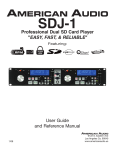




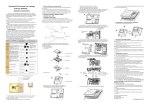


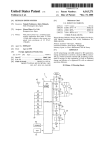
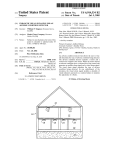

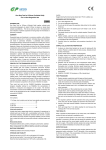
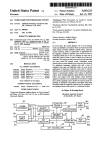

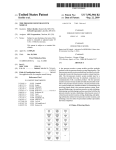

![`95385109 1%]?](http://vs1.manualzilla.com/store/data/005699459_1-7fc02fda0f8970d7c2f678aea00486d8-150x150.png)
